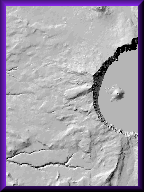 |
More on DEMs |
All 7.5-minute DEMs in the lower 48 contiguous states made from contour lines are classified into two major resolution groups: 30-meter and 10-meter grid posting. The 30-meter DEM is the standard product produced by the USGS. The area covered in the 30-meter DEM is split into squares with 30-meter sides; hills or valleys smaller than the 30-meter cells will not show up. In an effort to improve the data, the USGS recently experimented in producing 10-meter DEMs. These 10-meter DEMs come from the same data source: the DLG with 20 and 40 feet contours. No new elevation, enhancement, or any additional information has been included. The elevation information is interpolated down to a finer resolution to produce a closer grid spacing DEM, thus portraying the earth's surface in a finer detail.
The 7.5- and 15-minute DEMs are within the large-scale category, the 2-arc-second DEMs are within the intermediate-scale, and the 1-degree DEMs are within the small-scale category.
Large Scale
The 7.5-minute DEM data correspond to USGS 7.5-minute (1:24,000 and 1:25,000 scale) topographic quadrangle map series for all of the United States and its territories. The spacing of elevations along and between each profile is 30-meter in Universal Transverse Mercator (UTM) projection.
The 7.5-minute Alaska DEM data correspond to the USGS 7.5-minute topographic quadrangle map series of Alaska by unit size. The elevations are referenced horizontally to the geographic (latitude/longitude) coordinate system of the North American 1927 Datum (NAD 27) or the North American 1983 Datum (NAD 83). The spacing of elevations along and between each profile is 1-arc-second of latitude by 2-arc-second of longitude.
The 15-minute DEM data correspond to USGS 15-minute (1:63,360 scale) topographic quadrangle map series of Alaska by unit size. The elevations are referenced horizontally to the geographic (latitude/longitude) coordinate system of NAD 27. The spacing of elevations along and between each profile is 2-arc-second of latitude by 3-arc-second of longitude.
Extent of Coverage: The UTM-based 7.5-minute DEMs are available for much of the contiguous United States, Hawaii, Puerto Rico, and portions of Alaska. The geographic-based 15-minute Alaska DEM data are available for most of Alaska.
Intermediate Scale
The 2-arc-second DEM data for the east half of the United States correspond to USGS 30- by 30-minute topographic quadrangle map series. Data for the west half of the United States (including Hawaii) correspond to the 30- by 60-minute topographic quadrangle map series. Each 2-arc-second unit is produced and distributed as four 15- by 15-minute cells. The spacing of elevations along and between each profile is 2 arc seconds.
Extent of Coverage: The 2-arc-second DEM data are available for portions of the contiguous United States and Hawaii.
Small Scale
The 1-degree DEM data for the east half of the United States correspond to USGS 1- by 1-degree topographic quadrangle map series. Data for the west half of the United States correspond to the 1- by 2-degree topographic quadrangle map series. The elevations are referenced horizontally to the geographic (latitude/longitude) coordinate system of the World Geodetic System 1972 Datum. The spacing of elevations along and between each profile is 3 arc seconds.
Extent of Coverage: The 1-degree DEM data are available for all of the contiguous United States, Hawaii, and most of Alaska. The images (1-degree mosaic data) cover only the contiguous United States.